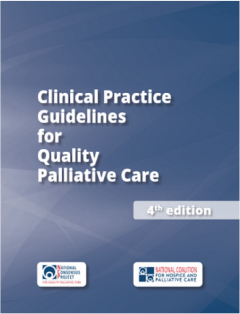Improving Quality of Serious Illness Care
In the United States each year there are millions of people living with serious illnesses that impact the quality of life for each patient, their families, and caregivers. Serious illnesses include many disease types and chronic illnesses such as cancer, heart disease, kidney failure, Alzheimer’s, chronic obstructive pulmonary disease (COPD), and many more. Serious illness affects both children and adults.
Palliative care is an approach to serious illness care that improves the quality of life of patients, their families, and caregivers. The purpose of the Clinical Practice Guidelines for Quality Palliative Care, 4th edition (NCP Guidelines) is to improve access to quality palliative care for all people living with serious illness regardless of their diagnosis, prognosis, age or where they live or receive care.

Clinical Practice Guidelines for Quality Palliative Care, 4th edition
Create a blueprint for excellence by establishing a comprehensive foundation for gold-standard palliative care, including evidence-based processes and practices for providing safe and reliable high-quality care for all people living with serious illness, regardless of their diagnosis, prognosis, age or where they live or receive care.
The Clinical Practice Guidelines for Quality Palliative Care delineate palliative care principles that clinicians can integrate into the care of seriously ill patients and their families. Health care organizations can choose how to best apply the guidelines criteria based on their patient populations and care settings. The fourth edition of the Clinical Practice Guidelines for Quality Palliative Care expands on the information provided in the eight areas (domains) of palliative care identified in the previous editions.
The Clinical Practice Guidelines for Quality Palliative Care, 4th edition:
- feature recommendations for integrating palliative care principles and best practices for all clinicians, and
- foster consistent standards and criteria and encourage continuity of palliative care across settings,
- focus on specific clinical and organizational strategies, including treatment considerations and screening and assessment elements, facilitated by practice examples, tools and resources.
The Clinical Practice Guidelines for Quality Palliative Care, 4th edition, are organized into 8 domains:
| Domain | Description |
| Domain 1: Structure and Processes of Care | The composition of an interdisciplinary team is outlined, including the professional qualifications, education, training, and support needed to deliver optimal patient- and family-centered care. Domain 1 also defines the elements of the palliative care assessment and care plan, as well as systems and processes specific to palliative care. |
| Domain 2: Physical Aspects of Care | The palliative care assessment, care planning, and treatment of physical symptoms are described, emphasizing patient- and family-directed holistic care. |
| Domain 3: Psychological and Psychiatric Aspects | The domain focuses on the processes for systematically assessing and addressing the psychological and psychiatric aspects of care in the context of serious illness. |
| Domain 4: Social Aspects of Care | Domain 4 outlines the palliative care approach to assessing and addressing patient and family social support needs. |
| Domain 5: Spiritual, Religious, and Existential Aspects of Care | The spiritual, religious, and existential aspects of care are described, including the importance of screening for unmet needs. |
| Domain 6: Cultural Aspects of Care | The domain outlines the ways in which culture influences both palliative care delivery and the experience of that care by the patient and family, from the time of diagnosis through death and bereavement. |
| Domain 7: Care of the Patient Nearing the End of Life | This domain focuses on the symptoms and situations that are common in the final days and weeks of life. |
| Domain 8: Ethical and Legal Aspects of Care | Content includes advance care planning, surrogate decision-making, regulatory and legal considerations, and related palliative care issues, focusing on ethical imperatives and processes to support patient autonomy. |

The Clinical Practice Guidelines for Quality Palliative Care, 4th edition, feature specific clinical and organizational strategies, including treatment considerations and screening and assessment elements, facilitated by practice examples, tools and resources.
The Clinical Practice Guidelines for Quality Palliative Care, 4th edition are intended to encourage and guide health care organizations and clinicians (including non-palliative care specialists) across the care continuum to integrate palliative care principles and best practices into their routine assessment and care of all seriously ill patients. Also, the Clinical Practice Guidelines for Quality Palliative Care, 4th edition formalize and delineate available evidence-based processes and practices as well as consensus recommendations for the provision of safe and reliable high-quality palliative care for adults, children, and families with serious illness in all care settings.
Who wrote the guidelines?
First published in 2004, the guidelines were developed by the National Consensus Project for Quality Palliative Care, which was comprised of leaders from 16 national organizations that have extensive expertise in and experience with palliative care and hospice. The guidelines have been periodically updated to reflect the growth and evolution of palliative care and hospice and to meet the needs of a growing population of people living with serious illness.
More than 90 national organizations have endorsed the guidelines, including the American Cancer Society, American Heart Association/ American Stroke Association, American Board of Internal Medicine, American Academy of Pediatrics, American College of Surgeons and American Nurses Association.
The RAND Evidence-based Practice Center systematically reviewed the literature to formally grade the evidence and identify gaps for future research. Findings suggest that more well-designed trials of commonly used interventions in palliative care across populations are needed to bolster the evidence base in key areas, including early integrated palliative care, complementary therapies, and advance care planning. The complete findings of the systematic review are available online in a published article at Journal of Pain and System Management (doi:10.1016/j.jpainsymman.2018.09.008).
The guidelines were funded by a grant from the Gordon and Betty Moore Foundation to enable the National Coalition for Hospice and Palliative Care to convene a Stakeholder Summit, and develop, disseminate, and implement the 4th edition of the National Consensus Project Clinical Practice Guidelines for Quality Palliative Care. Additional support for the systematic review of the research evidence was provided by the Gordon and Betty Moore Foundation, Gary and Mary West Foundation, The John A. Hartford Foundation and Stupski Foundation.
Permission to Use or Reprint
To request permission to use or reprint any content from the 4th edition for articles, podcasts, graphics or other materials, contact the National Coalition for Hospice and Palliative Care. https://www.nationalcoalitionhpc.org/ncp-guidelines/
